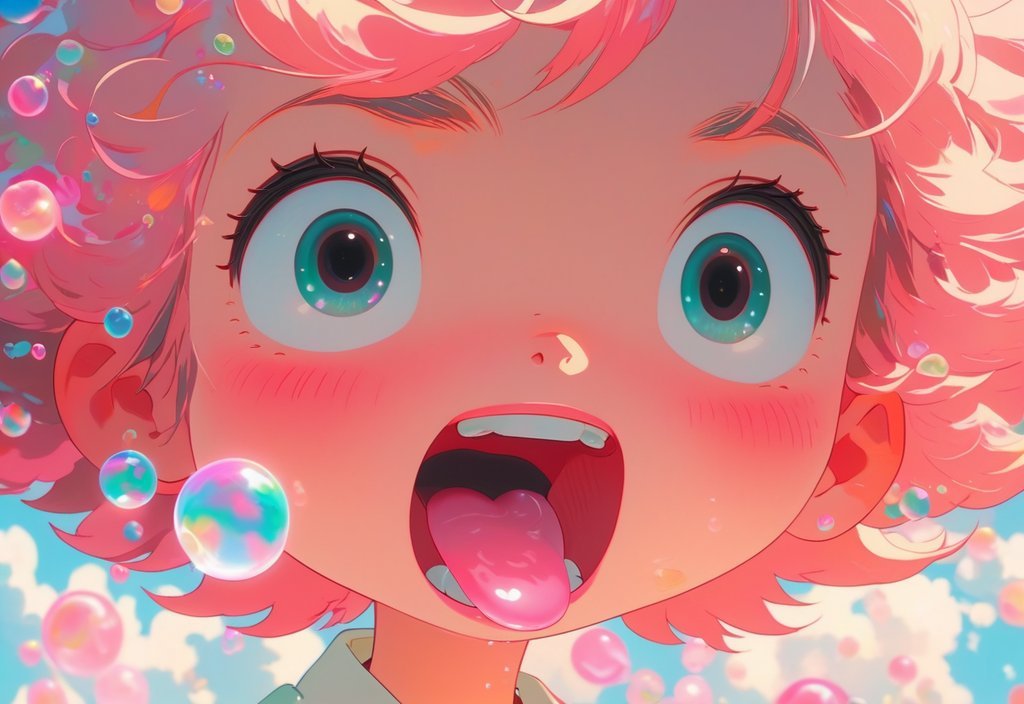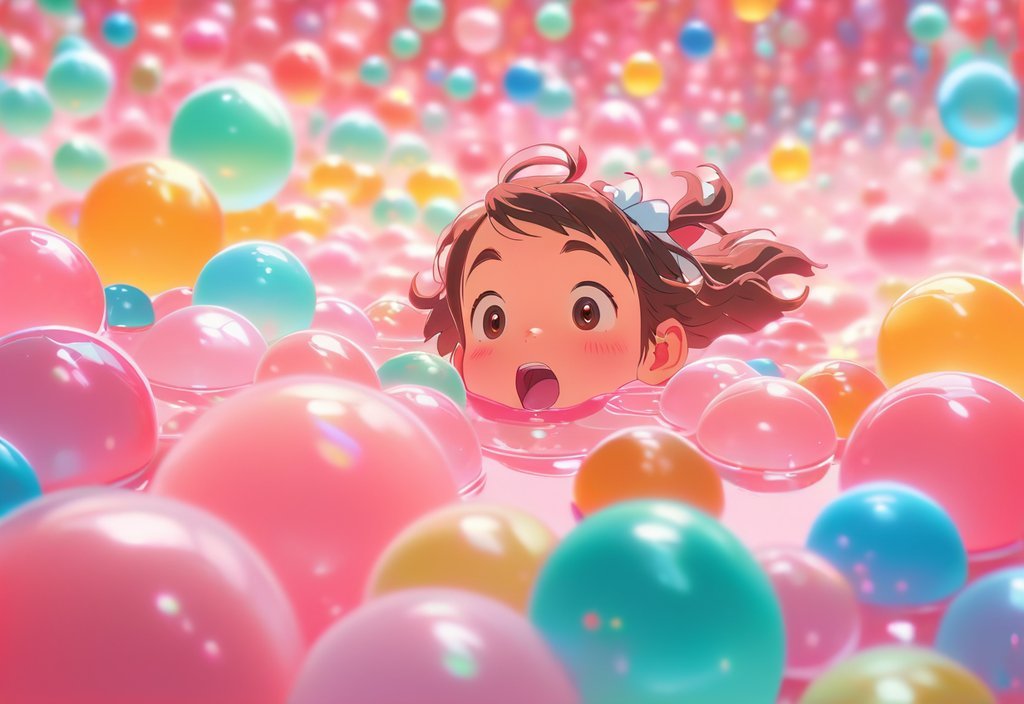Discover the captivating world of bubble gum as we delve into the fascinating facts surrounding this beloved confectionery delight. In this article, titled “Bubble Gum Uncovered: Unveiling the Fascinating Facts,” we will explore the intriguing history, the mesmerizing production process, the captivating chemistry, and the profound cultural impact of bubble gum. Get ready to embark on a journey filled with surprising tidbits and enthralling discoveries about this chewy treat that has captured the hearts and taste buds of people around the globe.

Key Takeaways:
- Ancient Greeks used resin-based gum for stress relief, indicating the early origins of chewing gum.
- The largest bubble ever blown measured 23 inches in diameter, as recorded by the Guinness Book of World Records.
- Worldwide, approximately 100,000 tons of bubble gum are consumed annually.
- Between 23.7% and 26.8% of gum chewers consume it two or three times a week.
- Over 160 million people in the US used chewing gum or bubble gum in 2020.
- America is projected to make up 12.3% of the global chewing gum market by 2025.
- Swallowed gum does not stay in the gastrointestinal tract for seven years; it passes through the system as any other food.
- Approximately 60 to 70 percent of bubble gum consists of sugar.
- Chewing gum has been found to potentially reduce stress and aid concentration, contrary to popular belief.
Facts About Bubble Gum
As we delve into the fascinating world of bubble gum, prepare to be amazed by the interesting and quirky facts surrounding this chewy delight. From ancient Greeks finding stress relief to record-breaking bubble blowing, there’s so much to discover about bubble gum’s history, consumption, and more. Let’s unravel the secrets and uncover the facts:
Ancient Origins and Stress Relief
Did you know that the use of gum for stress relief dates back to ancient times? According to tastessence.com, the ancient Greeks discovered a form of chewing gum made from resin. It was believed to provide relief from stress, offering a moment of calm in the midst of chaos. This fascinating practice has been passed down through generations, with bubble gum now being a popular choice for stress-busting today.
Record-Breaking Bubbles
When it comes to bubble gum, size does matter! As noted by the Guinness Book of World Records, the largest bubble ever blown measured a whopping 23 inches in diameter. Just imagine the amount of chewing gum and lung power required for such a feat! This extraordinary accomplishment showcases the incredible potential of bubble gum and the boundless joy it brings to both young and old alike.
Global Consumption
The consumption of bubble gum is truly staggering. According to uselessdaily.com, a mind-boggling 100,000 tons of bubble gum is chewed worldwide every year. That’s equivalent to the weight of nearly 20,000 elephants! Furthermore, between 23.7% and 26.8% of regular gum chewers enjoy their bubble gum two or three times a week. The popularity and widespread usage of bubble gum continue to reach new heights globally.
Bubble Gum’s Popularity in the US
It’s no secret that bubble gum holds a special place in the hearts of millions of Americans. In 2020, over 160 million people in the US alone enjoyed the delights of chewing gum or bubble gum, as reported by soocial.com. This widespread adoration for bubble gum is anticipated to continue, with America estimated to account for 12.3% of the worldwide chewing gum market by 2025, according to uselessdaily.com.
Debunking the Myth
Let’s set the record straight when it comes to a popular belief surrounding swallowed gum. Contrary to the misconception that gum stays in the gastrointestinal tract for seven years, uselessdaily.com states that this is far from the truth. Like other food items, swallowed gum passes through the digestive system and is eliminated in due course. So don’t worry, your favorite gum won’t be sticking around for seven years!
The Sweet Chemistry of Bubble Gum
Have you ever wondered what makes bubble gum so deliciously sweet? Well, it turns out that approximately 60 to 70 percent of bubble gum is comprised of sugar, according to uselessdaily.com. This sugary component gives bubble gum its delightful taste and chewiness, making it an irresistible treat for many.
The Stress-Relieving and Focusing Chomp
If you find yourself reaching for bubble gum during stressful moments, you’re not alone. Tastessence.com affirms that the act of chewing gum has been linked to stress reduction and improved concentration. So, whenever you’re feeling overwhelmed or in need of a mental boost, consider grabbing a piece of bubble gum and chomping away to help enhance your focus and calm your mind.
Bubble gum truly holds a fascinating place in our lives, from ancient stress relief practices to record-breaking bubble blowing adventures. Its consumption on a global scale and popularity in the US speak volumes about its enduring appeal. So, whether you’re blowing bubbles or savoring the sweet taste, bubble gum continues to bring joy and excitement to chewers of all ages.
So, grab your favorite pack of bubble gum, pop a piece in your mouth, and enjoy the satisfying chewiness that this beloved confectionery delight has to offer. Happy chewing!
Did you know that the Philippines is known for its fascinating culture and rich history? Discover some intriguing facts about the Philippines by clicking here.
If you’re curious about lacrosse, click here to uncover interesting facts about this thrilling sport.
Calling all wrestling enthusiasts! Get ready to be amazed by checking out some mind-boggling facts on wrestling here.
Turkey is not only famous for its delicious cuisine but also has an array of interesting facts. Click here to learn more about this remarkable country.
Ever wondered about the secrets hidden in hills? Explore fascinating facts about hills by clicking here.
Curious about the history and significance of paper? Dive into the realm of paper and its intriguing facts by clicking here.
Production Process of Bubble Gum
Bubble gum is a beloved confectionery delight enjoyed by people of all ages. But have you ever wondered how this chewy treat is made? In this article, we will take you through the step-by-step production process of bubble gum, revealing the fascinating journey from raw ingredients to the final delicious product.
Step 1: Preparing the Gum Base
The production process of bubble gum starts with the preparation of the gum base. This crucial step involves mixing small pellets of plastic and rubber together with color and flavoring. These ingredients are blended in a large machine with rotating blades to ensure a uniform consistency. Heat is then applied until the mixture melts into a thick, syrupy substance.
Step 2: Adding Glucose Syrup
Once the gum base is melted, the next step involves adding glucose syrup to the mixture. This syrup serves two purposes: to provide sweetness to the gum and to maintain its soft and chewy texture. The mixture undergoes further heating to ensure the glucose syrup is fully incorporated.
Step 3: Cooling and Increasing Chewiness
After the gum base and glucose syrup are mixed together, the mixture is transferred to a cooling chamber. Here, it undergoes a cooling process for approximately 15 minutes. This cooling step plays a crucial role in enhancing the chewiness of the bubble gum.
Step 4: Cutting and Wrapping
Once the gum has been sufficiently cooled, it is ready to be cut into individual pieces and wrapped. Specialized machines are used to cut the gum into thin strips, and then each piece is individually wrapped. This final step ensures that the bubble gum is not only ready for consumption but also easy to handle.
The production process of bubble gum involves a careful combination of ingredients and techniques. Each step, from preparing the gum base to cutting and wrapping the final product, is crucial in creating the chewy and flavorful treat that we all know and love.
Source:
- ESL Brains – How is bubble gum made
- Gumball Machine Warehouse – How is bubblegum made
Key Takeaways:
- The production of bubble gum involves mixing plastic and rubber pellets, color, and flavoring to create the gum base.
- Glucose syrup is added to the gum base to provide sweetness and maintain a soft and chewy texture.
- Cooling the gum mixture enhances the chewiness of the bubble gum.
- Specialized machines are used to cut the gum into individual pieces and wrap them for easy handling and consumption.
Chemistry Behind Bubble Gum
Bubble gum, a beloved confectionery delight, is not just about its fun and chewy texture. There’s actually a fascinating science behind its ability to blow bubbles. In this article, we’ll delve into the chemistry behind bubble gum and discover the secrets behind this enjoyable activity.
The Science of Blowing Bubbles
The composition of bubble gum plays a crucial role in its bubble-blowing ability. Bubble gum contains polymers, which are long chains of molecules that provide the gum with its elasticity and stretchiness. When you chew gum, it releases these polymers, creating a viscous liquid that can stretch up to five times its original size.
But how does blowing a bubble work? When you stretch the gum into a thin film, it traps the air inside, creating a bubble. The elasticity of the gum allows it to form this thin film, which reflects light and gives bubbles their vibrant and colorful appearance. The trapped air inside the bubble adds to its size and creates its characteristic round shape.
The Role of Chewing
The process of chewing gum also contributes to the formation of bubbles. As you chew gum, the friction and pressure applied by your teeth and jaws release the polymers from the gum, allowing them to form long chains. This increases the viscosity of the gum, making it more stretchable and capable of forming bubbles.
Composition Matters
Bubble gum is made from synthetic rubbers that contain extended chains of polymers. These synthetic materials allow for longer-lasting flavor, a softer texture, and reduced tackiness compared to natural rubber, such as chicle. The polymers in bubble gum provide the necessary elasticity for the bubble-blowing process to occur.
Key Takeaways:
- The composition of bubble gum, including the presence of polymers, is essential for creating bubbles.
- Chewing gum releases polymers, increasing the gum’s viscosity and making it more stretchable.
- Bubble gum’s ability to blow bubbles is due to its elasticity and the formation of a thin film when stretched.
- Bubble gum is made from synthetic rubbers with extended polymer chains.
- The air trapped inside a bubble contributes to its size and round shape.
Sources:
1. What Makes Bubble Gum Blow Bubbles
2. How to Blow Bubbles with Gum: The Ultimate Guide
Cultural Impact of Bubble Gum
Bubble gum may seem like a simple and lighthearted treat, but it has had a significant cultural impact throughout history. From its invention to its evolution and global popularity, bubble gum has become an iconic symbol of fun and nostalgia. Let’s delve into the fascinating facts surrounding the cultural impact of bubble gum.
The Invention and History of Bubble Gum
In 1928, Walter Diemer, an accountant for the Fleer Chewing Gum Company, created the first successful bubble gum[^1]. Diemer’s invention revolutionized the chewing gum industry and laid the foundation for the cultural impact of bubble gum.
Pink Perfection: The Color of Bubble Gum
One interesting fact about bubble gum is its signature pink color. Walter Diemer used a pink dye because it was the only color available at the Fleer Chewing Gum Company[^3]. This choice has since become the industry standard, and pink bubble gum continues to be synonymous with the joy of blowing bubbles.
Evolution of Bubble Gum
Over the years, bubble gum has evolved in various forms and flavors, offering consumers a wide variety of options[^4]. From the original sugary pink gum to gumballs and small individually wrapped pieces, bubble gum has adapted to cater to different preferences and tastes. This versatility has contributed to its continuing popularity and cultural significance.
The Joy of Chewing
Bubble gum has become an iconic treat cherished by people of all ages. Its consumption and popularity demonstrate its enduring appeal globally[^5]. Chewing bubble gum brings joy, excitement, and stress relief to individuals, making it a beloved cultural pastime.
Key Takeaways:
- Walter Diemer’s invention of bubble gum in 1928 revolutionized the chewing gum industry and set the stage for its cultural impact[^1].
- The pink color of bubble gum originated due to the availability of pink dye at the time, and it has since become the industry standard[^3].
- Bubble gum has evolved into various forms and flavors, ensuring a wide range of options for consumers[^4].
- Bubble gum’s enduring popularity and cultural significance stem from the joy, excitement, and stress relief it brings to people of all ages[^5].
Sources:
[^1]: The Invention and History of Bubble Gum – ThoughtCo
[^3]: Why Pink? – ThoughtCo
[^4]: Evolution of Bubble Gum – ThoughtCo
[^5]: How Bubble Gum Has Changed Society – Internet Public Library

FAQ
Q1: What are some interesting historical facts about bubble gum?
A1: Bubble gum has a rich history, with the first successful invention credited to Walter Diemer in 1928. Early attempts at creating bubble gum were considered too wet and often broke before bubbles could be blown. Additionally, Diemer’s choice of pink dye for the gum has since become the industry standard.
Q2: How much bubble gum is consumed worldwide?
A2: According to statistics, approximately 100,000 tons of bubble gum are chewed worldwide every year. It is estimated that between 23.7% and 26.8% of those who chew gum consume it two or three times a week.
Q3: Does swallowing gum really stay in your system for seven years?
A3: No, contrary to popular belief, swallowed gum does not stay in the gastrointestinal tract for seven years. It typically passes through the digestive system and is excreted like any other food.
Q4: What is the largest bubble ever blown?
A4: As recorded by the Guinness Book of World Records, the largest bubble ever blown measured 23 inches in diameter.
Q5: Does chewing gum really help reduce stress and improve concentration?
A5: Yes, chewing gum has been found to help reduce stress and improve concentration, according to some studies.
- Guatemala vs. Costa Rica: Plan Your Trip Smartly - April 16, 2025
- Master Types of Pumps: Ultimate Guide to Selection - April 16, 2025
- Unlock Types of Makeup Secrets: Master Any Look Now - April 16, 2025
















